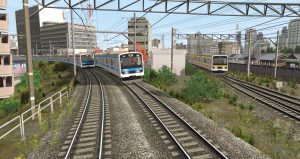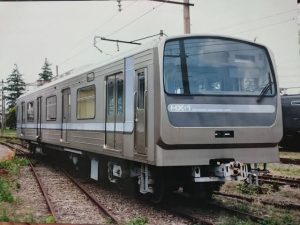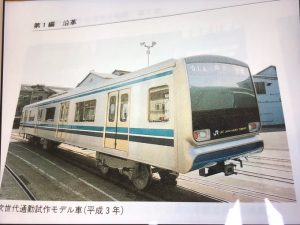Part of the “209 Series & derivatives” megapack – jump to the next part.

From left to right: 901 Series, Keihin-Tohoku Line 209 Series, Nambu Line 209 Series
DOWNLOAD
All the necessary dependencies are either included in this package or are avaible on the DLS. Soundscript by Rizky_Adiputra.
(Consists are included! Don’t bother with placing individual cars!)
Unlike the other JR Group companies, after the privatization of JNR, JR East decided not to immediately design new commuter and suburban trains design, and instead opted to continue production on some of the late JNR designs, mainly the 205 Series and the 211 Series, in order to “take time” to eventually develop a more advanced replacement for the 103 Series, wich despite the attempted mass-scale introduction of new series trains by the now-defunct national railways, was still the mainstay of almost all commuter lines in Tokyo, having been completely replaced only on the Chuo Line (by the 201 Series) and only partly on the Yamanote Line (by the 205 Series) by the time JNR got privatized.
The 103 Series was considerably heavy, as it had been manufactured out of carbon steel, and had a relatively high energy consumption compared to it’s immediate successors. Furthemore, since it was concieved in the early 1960s, during the economic miracle and rapid urbanization and subsequent rapid constant increase in ridership of railway lines, it was designed to be as simple, cheap and quick to manufacture as possible, and was subsequently produced for 20 straight years, from 1963 to 1983 as JNR’s standard commuter train.
Therefore, in its early years, JR East was facing some serious issues, as by the late 1980s most 103 Series sets were seriously ageing, and the series as a whole rapidly becoming more and more of an hurdle for the company.
Out of all JR East lines, the one with the most urgent need of rolling stock was the Keihin-Tohoku Line, wich depsite being one of the most important commuter lines, it was still operated almost entirely with 103 Series trains, along with a small fleet of relatively newer 205 Series trains ordered almost as an emergency mesaure piggybacking on a larger Yamanote Line order.
Therefore, in the early 1990s JR East started the first serious design workings for a 103 Series replacement. Another issue was the eventual long-term technological obsolescence, as JR East felt it couldn’t keep up with the rapidly-developing electronics application in railway transport with trains that had a “traditional” lifespan of 30-50 years.
Furthemore, not only JR East had to replace 103 Series trains on the “core” urban lines, but also on numerous suburban and rural lines as well, something that would’ve taken a few decades, thus hypotetically, once all old trains had been replaced by new trains, it would’ve needed to start again, as the “new trains” that were introduced on the main lines by that time were now “old”, and such circle would’ve repeated itself indefinitely.
In the end, JR East decided to break entirely with the tradition of JNR-derived designs, opting instead for a completely new rolling stock concept – “half the weight, half the cost, half the lifespan”:
By using stainless steel bodyshells (as proven with the 205 Series) a train could be made to be “half the weigth” of a conventional carbon-steel one, wich meant less wear and tear, less maintainance needs for rolling stock and infrastructure wich would result in a cost reduction wich coupled with scale economies trough mass production meant the new trains would be nearly “half the cost” of equivalent ones, and thus larger amounts could be procured for the same price. Finally, “half the lifespan” meant that rather than spend all of it’s 30 years of service life on one line, the new trains would spend half of that lifespan on major lines, then be refurbished and cascaded to lesser-used lines where they would spend the remaining half. This had the double effect of having the major lines always have the lastest up-to-date stock, and would’ve meant a relative saving in rolling stock purchase for the lesser-used lines, something that is always more-or-less regarded as a waste of money.
Breaking from the old JNR tradition of “in-house design” (for the vast majority of it’s existance, JNR had designed it’s rolling stock almost entirely on it’s own, contracting the manufacturing to the various rolling stock builders, wich had little input in the design, something that was changed only with the very last JNR designs), JR East opted for the manufacturers to have ample flexibility in drawing up their proposals for a new commuter train design, limiting it’s job only to giving out the necessary specs: the new 103 Series replacement was to be a 1500v mono-voltage commuter electric multiple unit with 20m-long cars with four doors per side, to be made out of stainless steel. Another important requirement was the traction system: the new trains were to use the then-brand new VVVF inverter control, coupled with regenerative braking, in lieu of the now long-obsolete resistor control or the slightly less modern chopper control.
In the early 1990s, three manufacturers proposed their designs, with two demonstrating theirs with a mock-up car: an “HX-1” prototype by Hitachi, more or less an updated version of the 205 Series and a “KX-1” prototype by Kawasaki, wich had completely smooth sides with an FRP front mask and was based on the company’s previous experience with subway trains (primarily Tokyo’s TRTA ones) and the late JNR and early JR suburban trains (such as the 211 and 311 Serieses).
A third proposal was also made by Nippon Sharyo, with an “NX-1” prototype, pictures of wich are rather elusive.
Out of three, Kawasaki’s design was selected as the best, with the company being contracted, in collaboration with Tokyu Car Co. and JR East’s Omiya Works to manufacture three 10-car prototype trains to be tested in revenue service.
Classified as the “901 Series”, denoting the experimental nature of the fleet, the three 10-car sets, numbered A, B and C were delivered to Urawa depot in March 1992 for services on the Keihin-Tohoku Line.
Each of the three sets fetaured different technical solutions, with each train fetauring a different GTO-VVVF inverter (Fuji Electric, Toshiba and Mitsubishi Electric), window opening system, presence or less and style of hanging straps, FRP front mask thickness, door system, driving desks (set A and C had two-handle master controllers, one of wich derived from the one of the 205 Series and set B had a one-hand master controller derived from the one of JR Hokkaido’s 721 Series) and so on…
Another notable fetaure of the 901 Series was that for the first time for a commuter train, external design was made one of the primary concerns, with the GK Design studio, led by famous designer Kenji Ekuan, being contracted to give the new trains a more modern and distinct look from the old 103 Series.
After a full year of testing, the definitive design for the new trains was finalized, and consisted in an amalgamation of the best solutions found in each trains (such as the MELCO inverter of Set C, the one-handle master controller of set B and the bodyshell manufacturing technique of set A). Finally, the full-production “New Series Trains”, classified as the “209 Series” began to be manufactured en-masse in early 1993, with the first sets entering full service on the Keihin-Tohoku Line in March 1993. The new trains were immediately well recieved by both passengers and railwaymen alike: they were comfortable, quiet and smooth, a far cry from the old 103 Series. Shortly after, in 1994, the three 901 Sets were converted to mass-production standards, being reclassified as the 209-900 Series.
In order to ease overcrowding on the Keihin-Tohoku Line (and on similar lines), the soon-to-be infamous six-door “no seating” “cattle cars” began to be rolled out in the early 1990s, with the 209 Series being no exception. By 1995 all of the half-way delivered fleet was retrofitted with one six-door car, with the rest of the fleet being built with such car already in formation. Finally, the last set out of the 78 ordered for the Keihin-Tohoku Line was delivered in 1997, with the long-awaited replacement of the 103 Series finally arriving with the spring timetable change of 1998, with the last run of a 103 Series being made on the 10th of March, after wich the fleet of the Keihin-Tohoku Line was standardized to the 209 Series (the few 205 Sets had already been replaced in 1996 and moved to other lines).
Besides the Keihin-Tohoku Line, the Nambu Line also got the 209 Series, but in a far small number: just two six-car sets (numbered 1 and 32) were delivered in March 1993 to Nakahara depot in order to “fill the gap” left by the transfer of two 205 Series trains to the Yokohama Line (in order to unify the latter’s fleet) and to supplement the existing 103 Series. The two Nambu Line sets were otherwise exactly identical to their longer Keihin-Tohoku Line siblings, barred obvious differences (livery, 6-car formation, lack of 6-door car).
Overall, the 209 Series had lived a tranquil, relatively uneventful life until the mid-2000s, however soon the time came for a major fleet modification: by 2007 the 209 Series had reached it’s famous “half the lifespan” 15 years deadline, thus it was time for the 209 Series to leave the Keihin-Tohoku Line to a newer, more up-to-date train – the E233 Series, specifically the -1000 Subseries.
Introduced in 2007 as derivatives of the Chuo Line E233-0 Series tailored for the Keihin-Tohoku Line, the E233-1000 Series began to replace the 209 Series on a train-per-train base, starting from the three “ex-901” Series 209-900 Series sets, wich were all withdrawn by the end of that year and scrapped (except for KuHa 901-1, the cab car of ex-901 Series Set A, wich was saved and is now preserved inside the Tokyo General Rolling stock center), while the mass-production sets were to be converted and displaced to regional lines. By late 2009 enough E233-1000 Series sets had been delivered to fully replace the 209 Series on Keihin-Tohoku Line services, with such replacement being finalized in on the 24th of January 2010, with the last run of a Keihin-Tohoku Line 209 Series.
Surplus 209 Series trains from the Keihin-Tohoku Line were reclassified into three subserieses and diverted to two areas: the -2000 and -2100 Subserieses (the bulk of surplus trains) would end up in the Boso Area for regional services around Chiba, while the -2200 Subseries would end up on the Nambu Line.
All considered, the 209 Series was a major success for JR East, and quickly became the base for nearly all of the company’s conventional local electric multiple units, wether commuter, suburban (such as the E217 Series) or even rural trains, such as the E127 Series and the 20Kv AC 50Hz 701 Series for Tohoku Area services. Furthemore, the 209 Series became the inspiration for many other companies all over Japan, such as Hanshin Railway, to introduce their own stainless-steel trains. However, JR East didn’t stop there, deciding to carry out further developent of the 209 Series design, finally resulting in the masterpiece “millenium train”: the E231 Series, wich would go on to be the de-facto standard and main inspiration for all Japanese commuter trains that have been manufactured ever since.
Trivia #1:
The 209 Series was the first JR East train to adopt the now-standard single-handle master controller, however it’s introduction hadn’t been particularily smooth, as drivers found it hard to adjust to the new system, having been used to separate power and braking controls, and especially a “vertical axis” brake lever, wich most drivers were used to “judge” the braking notches by feeling the angle of the lever itself. However, the initial resistance soon became null, as drivers found out that the new single-handle master controller was more comfortable and less wearisome than the old controls arrangment.
Trivia #2:
The “half-the-lifespan” concept initially led to a misunderstanding (wich partly permeates today) as to the 209 Series having been concieved as some kind of “disposable train” in the same way such as disposable cameras and so on. This however has been proven wrong, as currently, nearly 30 years after the introduction of the series, nearly half of the manufactured vehicles are still in service, as exemplified by this diagram (wich is a little old, as i made it a couple of years ago, so it might not be entirely accurate as of today, but it gives you an idea…).
Bonus pictures:
The two mockup proposals for the 901 Series:
Hitachi’s HX-1, wich was roughly an updated 205 Series with a few modifications (note the very 1990s-esque central lights, as found on the Sotetsu 8000 and 9000 Series and the Osaka Subway New 20 Series). In the background, to the right, you can catch a glimpse of the experimental ED500 electric locomotive, built by Hitachi in the same year as the HX-1.

And Kawasaki’s winning proposal, the KX-1, wich already has a good deal of similarities to the production trains.

Bonus Video (3:18):
An extremely rare recording (probably the only one ever made) of the 901 Series prototypes in regular revenue service, specifically of set C. Note the two-handle driving cab arrangment, derived from the one of the 205 Series.
